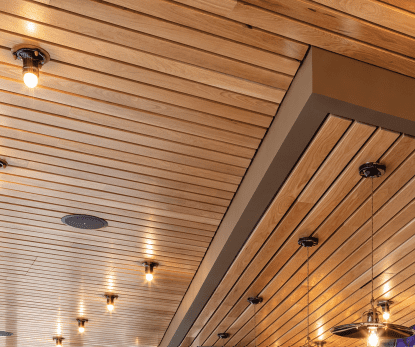It’s been estimated that “over 80% of all product-related environmental impacts are determined during the design phase of a product” (EU). That means you have the opportunity to make a big difference by committing to a sustainable design from the outset of your project. Thankfully, a sustainable design isn’t hard to achieve with products like wood wall systems on the market. Products like these balance aesthetics, functionality, and sustainability (all while being cost-effective), which makes them the perfect choice for any design.
The Big Benefits of Sustainable Design
The green movement has created new standards for those in the design and build industry.
1. Durability
Many sustainable materials, including wood, are long-lasting. When you’re working toward a sustainable design, you want to use durable materials that you know will stand the test of time. When you use sustainable building materials, you can count on longevity. If products like wood can naturally withstand harsh, changing climates for years while growing, then they can certainly handle being part of your project, functioning well for years to come.
2. Conservation
Sustainable building materials contribute to the conservation of energy and water. Sustainable manufacturing means less waste in landfills, but it also means big savings once everything is in place, and the products you use for your project can result in increased efficiency long after you’ve left the scene. Programmable thermostats, low-flow plumbing, and green insulation are all good options that help save money and protect the environment long-term.
3. Preservation
When you choose your sustainable building materials wisely, you can make an even bigger impact on the environment in a positive way. Using recycled materials or end-of-life materials mean those products are getting a second life rather than being tossed aside as waste and causing further damage to the environment. Want to help the planet further? You can decide to use only sustainably-harvested wood, which is an initiative that takes a tree for its beautiful lumber but does so with the intention of replanting for future growth.
4. Waste Reduction
Landfills are an unsustainable form of waste management, and when you choose sustainable materials such as wood for your project, you don’t contribute heavily to that environmental detriment. Sustainable building materials (such as renewable, recyclable, or end-of-life) are an important part of design because they’re used in the most productive way possible with a strong emphasis on using less; intended to reduce toxic chemicals and environmental impacts through their lives; and made to ensure sufficient resources for both now and in the future (EPA).
5. Improved Health
Sustainable building materials not only positively impact your project and the environment, but also the health of those who eventually come to occupy your space. When you incorporate products like wood wall systems into your design, you get results such as enhanced IAQ, which means stringent air quality standards are in place to provide a healthier indoor environment for occupants.
Choosing Well with Sustainable Design
What’s impressive about sustainable design is that it can have a positive economic, social, and environmental impact. In terms of economics, your design can actually change communities because it’s been established that “[l]ong-term socioeconomic benefits to a community and region may be realized if enough builders and building owners adopt sustainable design practices.”
In regards to social effect, a sustainable design will certainly benefit those who use your space since a “building environment can have both negative and positive impacts on the occupants’ quality of life.”
Finally, the environmental difference you make with your design can’t be emphasized enough, as you have the opportunity to improve the future by employing sustainable materials that “reduce impacts on natural resources and ecosystems.”
With so many proven benefits to sustainable design, it only makes sense for designers and owners to actively participate in it. Considering how radical transparency is becoming increasingly important, even in the corporate world, it means interest in CSR will continue to rise. The only question is, where will you stand on these matters?
Choose a Sustainable Design with Wood Wall Systems
At Rulon International, we’re proud to manufacture wood that’s harvested from sustainably managed forests. All of our products, including our wood wall systems, conform to several sustainability standards, including FSC, LEED v4, WELL, and HPD. So when it comes to sustainable design, you can rest easy knowing that any product from our company is an ecological, smart design choice that will have impacts you can feel good about.
To find out which sustainable building material is right for your next project, schedule a design call with our team today.





